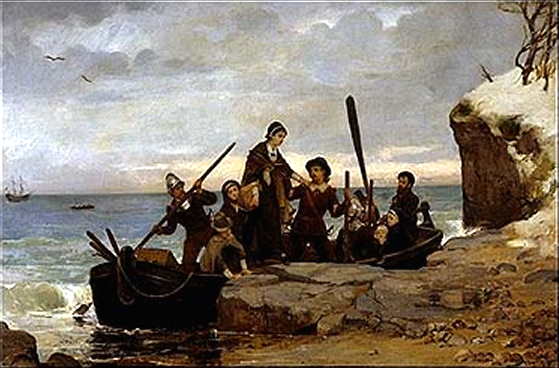 The Pilgrims had brought with them a shallop they had dismantled to fit onboard the Mayflower. It had also been damaged during the crossing and so its reparation and reassembling delayed exploration of the coast for two weeks. Finally exploration began under the leadership of Myles Standish, a soldier the Pilgrims met in Leiden and hired to assist them, and Christopher Jones, the Mayflower's master. They found an area of land deserted of all human life with vestiges of old buildings and recently cultivated fields. Artificial mounds which turned out to be Native American graves were discovered and in which they found baskets of maize which they took intending it for planting.
The Pilgrims had brought with them a shallop they had dismantled to fit onboard the Mayflower. It had also been damaged during the crossing and so its reparation and reassembling delayed exploration of the coast for two weeks. Finally exploration began under the leadership of Myles Standish, a soldier the Pilgrims met in Leiden and hired to assist them, and Christopher Jones, the Mayflower's master. They found an area of land deserted of all human life with vestiges of old buildings and recently cultivated fields. Artificial mounds which turned out to be Native American graves were discovered and in which they found baskets of maize which they took intending it for planting. By this time in late November and early December, most of the passengers and crew were becoming seriously ill due to the cold and damp weather. Others were suffering from scurvy. Nonetheless, exploration continued. On December 16th of our modern calendar, they made their first contact with the native population. Their shallop landed in the territory of the Nauset people surprising the locals they saw on shore. After having passed the night ashore and hearing the cries of the Nauset during the night, they were met the next day by flying arrows from the natives. The Europeans shot back with their arms chasing them into the woods where the Nauset were not to be found. They would have no more contact with the native populations for several months.
Finally on December 21th the first landing party arrived in the area which would become the settlement of Plymouth. They cleared the remains of the village Patuxet which had belonged to the Wampanoag people and whose residents were wiped out by a plague three years earlier. Construction began immediately and the first common house of the Pilgrims was completed on January 19th.
arrived in the area which would become the settlement of Plymouth. They cleared the remains of the village Patuxet which had belonged to the Wampanoag people and whose residents were wiped out by a plague three years earlier. Construction began immediately and the first common house of the Pilgrims was completed on January 19th.
Since the end of November many of the colonist had been sick and suffering with a horrible cough. Others were suffering from scurvey. Between the first landing and March of the following year, only 47 colonists out of 102 survived. Half of Mayflower's crew also died. John Carver, the governor died and William Bradford took over in his place. Mr. Bradford was the prime architect of the Mayflower Compact and his journal would later be published as Of Plymouth Plantation, the single authority on the history of the Pilgrims starting in 1608 until 1647.
Interesting links to learn to more :

No comments:
Post a Comment
Leave your comments or questions!!!